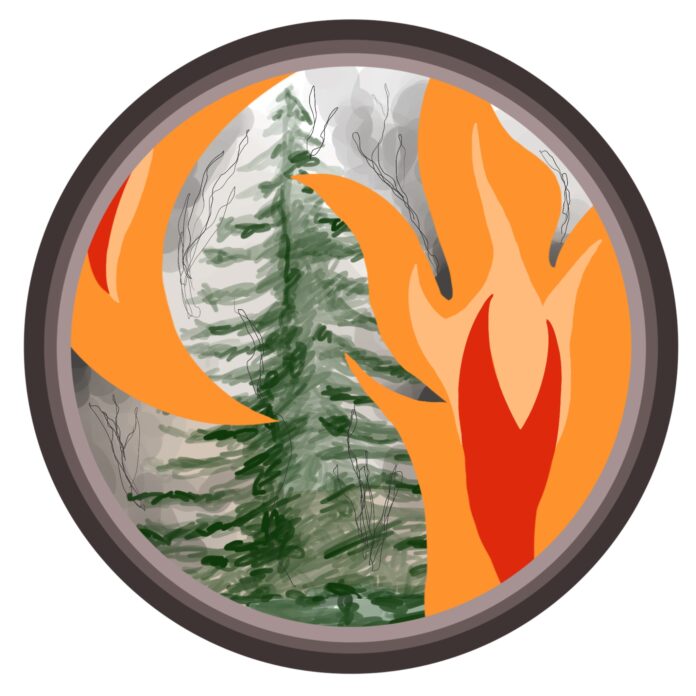The Ecological Legacies Lab at the University of Waterloo has published a collaborative paper between postdoctoral, graduate and undergraduate students on humanity’s long-term relationship and dependency on fire, which has been used to manage landscapes for generations under Indigenous fire stewardship.
Recent studies of parks and protected areas, including this one, have shown that Indigenous-managed lands are more biodiverse when compared to lands under conventional management.
Since the time of early humans, fire has been used as a tool for cultural purposes and land management. Fire was one of the first management tools used by humans which allowed them to shape their environments. The use of fire allowed humans to influence ecosystems and species diversity around them.
However, more historically recent events, including colonization, have led to fire suppression and changing fire regimes. This has resulted in incidents of large, destructive and uncontrollable wildlifes, as ecosystems are not prepared for such intense burns.
Wildfires are becoming more common, said professor Andrew Trant from the faculty of environment, supervisor of the paper.
“We are seeing hotter and drier temperatures across Canada and beyond, especially in the non-snowy seasons. These are the perfect conditions for wildfires, so once you add the spark, the fires burn,” Trant said. This is especially concerning as climate change brings with it a drier climate, warmer temperatures and conditions of drought in many areas, which have stretched wildfire seasons globally.
With such a long history of fire suppression, Trant noted how “this results in a build-up of wood, fuel, in the forests so that when they do burn, and they will, the fires are hotter and larger.” These more severe wildfires have devastating impacts on global biodiversity, as well as local human populations, often displacing local communities.
Implementing a controlled fire as a means of management allows humans to press what Trant and his team dub an “ecological reset button.” Indigenous Fire Stewardship, or IFS, also called cultural burning, is defined by Trant as “a knowledge system and practice that controls specific aspects of fire — severity, timing, behaviour, seasonality — to influence ecosystem structure, biomass, and community assemblages.” By routinely applying controlled fire to an ecosystem in order to adapt to changing environmental conditions, one can produce desired landscapes, habitats and species, while also supporting subsistence practices and livelihoods.
IFS has the ability to greatly decrease the severity of wildfires ignited by human means or other causes such as lightning strikes, by reducing the abundance of available fuels and increasing the fire resilience of surrounding vegetation. Trant said “it is also important to note that [IFS] supports intergenerational teachings of fire-related knowledge, beliefs, and practices. It’s practiced for a long list of benefits including hunting and subsistence, land clearing, habitat improvement for animals, soil fertilization, and for countless cultural reasons.”
As Indigenous communities have been displaced, the decreased ability to practice fire stewardship routinely has resulted in significant declines in biodiversity and especially the pyrodiversity of ecosystems. Pyrodiversity being the diversity and characteristics of fire in a region. Trant explained it as “the understanding of the feedbacks and connections between fire and the ecological processes, including biodiversity.”
As Trant said, “Indigenous peoples represent five per cent of the global population but protect around 85 per cent of the world’s biodiversity.” Today, Indigenous communities are revitalizing their fire stewardship practices after centuries of enforced fire suppression.
Trant said he is optimistic in the future of wildlife management with IFS, as “more frequent and less severe fires helps to reduce the amount of fuel in the forest, which will lessen the occurrence of catastrophic wildfires.” Though, “with a century of fire suppression, it does make it difficult, but it is entirely possible to reverse how these forests are being managed,” especially as ecosystems are undergoing rapid changes due to climate change and land-use changes.
Many Indigenous groups also face significant barriers to revitalizing fire stewardship initiatives, including risks associated with burning dead and dense fuels, the presence of highly flammable invasive species, laws prohibiting the cultural use of fire and in some cases the loss of knowledge associated with cultural fire practices.
In Canada, Amy Christianson, an Indigenous fire scientist, is highlighted by Trant to be “doing incredible work to understand the barriers, challenges and opportunities around cultural burning.” Christianson co-hosts a podcast titled ‘Good Fire,’ which looks at Indigenous uses of fire around the world and is noted by Trant to be an “amazing” resource for learning more about IFS.
Conserving global biodiversity is possible through integrating, valuing and supporting Indigenous-led approaches to fire stewardship and ecosystem management. “IFS offers us a different path forward — a path that has been time-tested and historically dismissed,” Trant said.
“For millennia, and in most landscapes, people have used fire in ways that have multiple benefits and, at the same time, create the conditions that maximize biodiversity.” So really, as Trant said, “what’s not to love?”






























